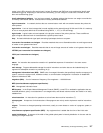IPX. Internetwork Packet Exchange
IRQ. Interrupt request.
iSCSI. A technology that enables the SCSI transport protocol over an IP network by connecting clients (initiators) and
servers to storage.
iSCSI client. A device that creates and sends SCSI commands to the target IBM IP Storage appliance.
iSCSI client logical-unit number (iLUN). A unique number that is assigned to each VLUN. The iLUN for a single
client starts at zero and increments sequentially.
J
jumper. A connector between two pins on a network adapter that enables or disables an adapter option, feature, or
parameter value.
jumper cable. Synonym for patch cable.
K
Kerberos. Pertaining to the security system of the Massachusetts Institute of Technology’s Project Athena. It uses
symmetric key cryptography to provide security services to users in a network.
L
LAN (see local area network).
local area network. A network in which a set of devices are connected to one another for communication and that
can be connected to a larger network.
LAN emulation client (LEC). A LAN emulation component that represents users of the emulated LAN.
LAN emulation configuration server (LECS). A LAN emulation service component that centralizes and
disseminates configuration data.
LAN multicast. Sending of a transmission frame that is intended to be accepted by a group of selected data stations
on the same local area network.
LAN Segment Number. The identifier that uniquely distinguishes a LAN segment in a multi-segment LAN.
LAN-to-LAN. An access mode for connecting remote LAN sites.
large-scale integration (LSI). The process of integrating large numbers of circuits on a single chip of semiconductor
material.
LBG (see load-balancing group).
LDAP (see Lightweight Directory Access Protocol).
Lightweight Directory Access Protocol. In TCP/IP, a protocol that enables users to locate people, organizations,
and other resources in an Internet directory or intranet directory.
limited broadcast. Synonym for single-route broadcast.
link aggregation. A type of bond group that combines the bandwidth of two or more ports to serve as one IP
address. The bond group distributes data across the bonded ports by using an algorithm. See bond group.
LIP. Loop initialization process
load-balancing group (LBG). A type of virtual network interface that comprises a set of physical and bonded
interfaces. A set of nodes within a virtual server that has layer-2 front-end connectivity can be collectively identified by
a unique IP address and grouped into a load-balancing group (LBG). The intent of such a grouping is to enable all
116 NAS 200 User’s Reference


















